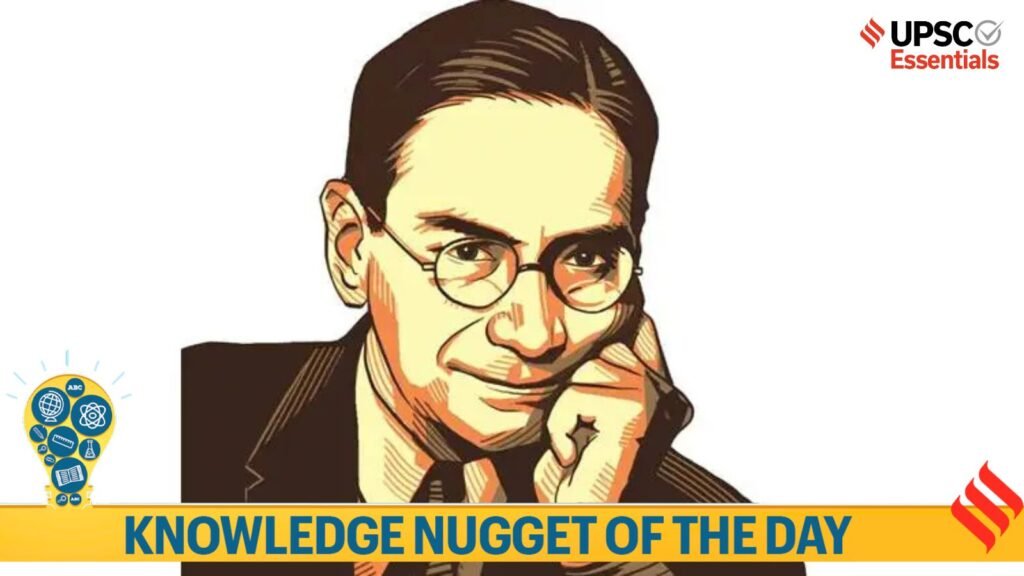Take a look at the essential events, concepts, terms, quotes, or phenomena every day and brush up your knowledge. Here’s your knowledge nugget for today on National Statistics Day and the legacy of the father of Indian statistics.
National Statistics Day is celebrated every year on June 29th to commemorate the birth anniversary of Prasanta Chandra Mahalanobis, the father of modern statistics in India. This year it will be observed under the theme “75 Years of National Sample Survey”, marking the significant contribution of the National Sample Survey in providing timely and reliable statistical data that supports evidence-based decision-making and governance in India. In this context, let’s understand the legacy of Prasanta Chandra Mahalanobis.
Key Takeaways :
1. In 2007, the Government of India designated June 29th as National Statistics Day to honour Mahalanobis’ birth anniversary. The first National Statistics Day celebration took place in 2007 and has since become an annual event that highlights the crucial role of statistics in national development.
2. The day aims to raise public awareness, particularly among the youth, about the importance of statistics in strategic planning, economic development, and policy-making.
3. This year, on the occasion, a number of significant statistical publications will also be released, such as Nutritional Intake in India 2022-23 & 2023-24 and the Sustainable Development Goals – National Indicator Framework Progress Report 2025.
4. Additionally, Ministry of Statistics and Programme Implementation (MoSPI) will introduce the GoIStat smartphone application, which was created to make official data easier to obtain.
Prasanta Chandra Mahalanobis
5. An Indian scientist and statistician, Prasanta Chandra Mahalanobis, has made significant contributions to the field of statistics and economic planning in India. He is renowned for the Mahalanobis distance, a statistical measure.
Story continues below this ad
6. Mahalanobis was born on June 29, 1893, in Calcutta (now Kolkata) in British India. He received his early schooling at the Brahmo Boys School, from where he graduated in 1908.
7. He played a pivotal role in the establishment of the Indian Statistical Institute (ISI) in 1931 and and lay the foundations of the Indian statistical system through the National Sample Survey Office (NSSO) and the Central Statistical Organisation (CSO). He made pioneering studies in anthropometry in India.
8. Mahalanobis was instrumental in designing the way we conduct surveys today. He introduced the concept of pilot surveys and advocated the importance of sampling methods. He also introduced a method for estimation of crop yields using statistical sampling.
9. During the latter part of his life, Mahalabonis was a part of the Planning Commission of India which was responsible for independent India’s five-year plans, in which he emphasized on the importance of industrialization and also corrected previous census methodology errors.
Story continues below this ad
10. Mahalabonis was deeply interested in cultural pursuits and was awarded one of the highest civilian awards, the Padma Vibhushan from the Government of India for his contribution to science. Mahalabonis died on June 28, 1972.
Mahalabonis Distance (MD)
11. Mahalabonis Distance (MD) is a multi-dimensional generalisation of the idea of measuring how many standard deviations away is point P from the mean of D. Apart from MD, which measures distance relative to the centroid – a base or central point which can be thought of as an overall mean for multivariate data.
BEYOND THE NUGGET: National Sample Survey (NSS) and MoSPI
1. The National Sample Survey Organisation has been conducting large scale sample surveys in diverse fields on All India basis since 1950. These surveys are conducted in the form of rounds extending normally over a period of one year though in certain cases the survey period was six months.
2. Primarily data are collected through nation-wide household surveys on various socio-economic subjects, Annual Survey of Industries (ASI), etc. Besides these surveys, NSS collects data on rural and urban prices and plays a significant role in the improvement of crop statistics through supervision of the area enumeration and crop estimation surveys of the State agencies. It also maintains a frame of urban area units for use in sample surveys in urban areas.
Story continues below this ad
Ministry of Statistics and Programme Implementation (MoSPI)
1. The MoSPI came into existence as an Independent Ministry on 15.10.1999 after the merger of the Department of Statistics and the Department of Programme Implementation.
2. The Ministry has two wings, namely, Statistics and Programme Implementation. The Statistics Wing called the National Statistical Office (NSO) consists of:
📌Central Statistics Office (CSO)
📌National Sample Survey Office (NSSO)
3. The Programme Implementation (PI) Wing has three Divisions, namely,
📌Central Twenty Point Programme (TPP)
📌Infrastructure and Project Monitoring (IPM)
📌Members of Parliament Local Area Development Scheme (MPLADS)
4. Besides, there is National Statistical Commission (NSC) created through a Resolution of Government of India (MOSPI) and one autonomous Institute, viz., Indian Statistical Institute (ISI) declared as an institute of national importance by an Act of Parliament.
Post Read Questions
Consider the following statements with reference to the contributions of Prasanta Chandra Mahalanobis:
1. He introduced the concept of pilot surveys.
Story continues below this ad
2. He was the first Chairperson of the Planning Commission of India.
3. He introduced a method for estimation of crop yields using statistical sampling.
4. He played a pivotal role in the establishment of the Indian Statistical Institute in 1931.
Which of the statements given above is/are correct?
(a) 1 and 2 only
(b) 1, 3 and 4 only
(c) 2, 3 and 4 only
(d) 1, 2, 3 and 4
(Sources: Who was Prasanta Chandra Mahalanobis or ‘PCM’?, mospi.gov.in)
Story continues below this ad
Subscribe to our UPSC newsletter. Stay updated with the latest UPSC articles by joining our Telegram channel – Indian Express UPSC Hub, and follow us on Instagram and X.
🚨 Click Here to read the UPSC Essentials magazine for June 2025. Share your views and suggestions in the comment box or at manas.srivastava@indianexpress.com🚨



